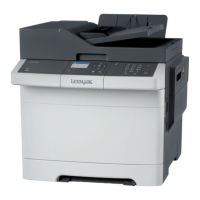Service tips
• The laser beam passes through a glass lens as it exits the laser unit. If this lens gets contaminated with toner or
other debris, it will cause vertical streaking of white/lightness on the page. Cleaning the lens will solve the problem.
• Never touch the surface of the photoconductor with your bare hand. The oil from your skin may cause a charge
differential on the surface, and toner will not properly stick. The result would be repeating blotches of voids/light
print on a page. Then the photoconductor will have to be replaced.
• The surface of the photoconductor is coated with an organic substance that makes it sensitive to light. Be sure to
cover the photoconductor when you are working on the printer so you don’t “burn” it. If exposed to light for too
long, it will cause light/dark print quality problems and will have to be replaced.
Step 3: Develop
When the laser exposes the photoconductor, the HVPS sends charge to the developer roll. For each color, the print
cartridge engages the photoconductor so it is in contact with the surface. Because of the charge difference between
the toner on the developer roller and the electrostatic image created by the laser, the toner is attracted to areas of the
photoconductor surface exposed by the laser.
This process would be similar to using glue to write on a can and then rolling it over glitter. The glitter sticks to the glue
but won’t stick to the rest of the can.
Service tips
• Never touch the surface of the developer roller with your bare hand. The oil from your skin may cause a charge
differential on the surface, and toner will not stick properly. The result would be repeating blotches of voids/light
print on a page. Then the affected cartridge will have to be replaced.
• If the developer roller is damaged, it will not contact the surface of the photoconductor properly. The result could
be repeating marks, thin vertical voids, or thin vertical lines of color on the printed page. Check the surface of the
developer for damage.
Step 4a: First transfer
When the latent images are developed on each Photoconductor, the HVPS sends voltage to the 1st Transfer Rollers
inside the ITU.
The charge difference between the developed toner image on the Photoconductor surface and the 1st Transfer Roller
causes the images to transfer to the surface of the ITU belt for each color. This takes place by a direct surface-to-surface
contact between the Photoconductors and the ITU transfer belt.
Service tips
• Never touch the surface of the ITU belt with your bare hand. The oil from your skin will cause a charge differential
on the surface, and toner will not stick properly. The result would be repeating blotches of voids/light print on a
page. Then the ITU belt will have to be replaced.
• Do not use solvents or other cleaners to clean the ITU belt surface. No matter how careful you are, the surface will
be compromised, causing scratches or a charge differential that will produce voids or light blotches on the printed
page. Then the ITU belt will need to be replaced.
Step 4b: Second transfer
When the four planes of color are transferred to the transfer belt from the photoconductors, the image is carried toward
the transfer roll, which is also part of the ITU. Based on the speed of the transfer belt, the proper time to send the signal
to pick the paper from an input source is determined. The pick is timed so that the paper passes between the transfer
belt and transfer roll when the image on the belt reaches the second transfer area.
7527
Appendix C: Theory of operation
364

